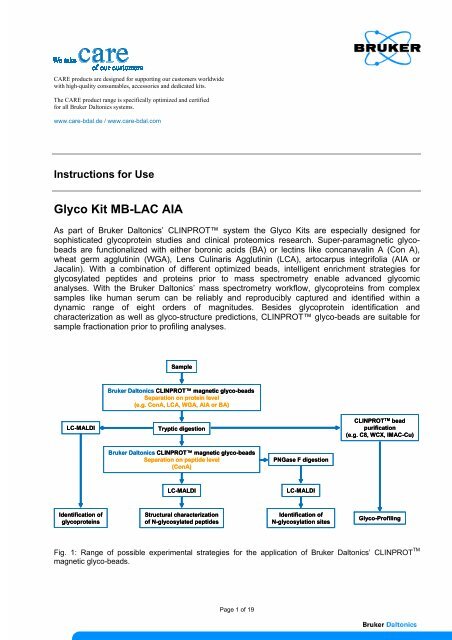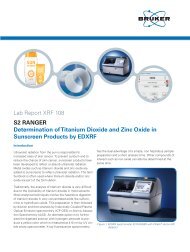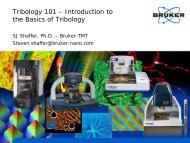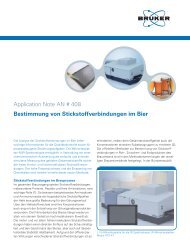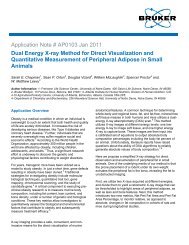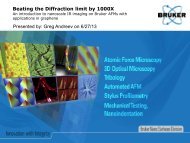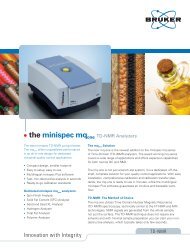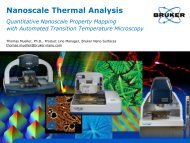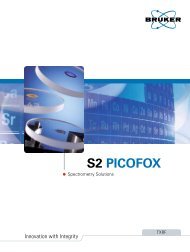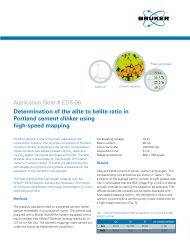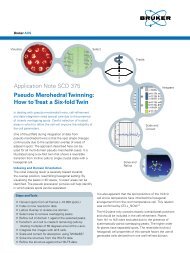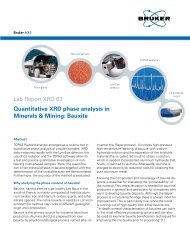Instructions for Use - Glyco Kit MB-LAC AIA - Bruker
Instructions for Use - Glyco Kit MB-LAC AIA - Bruker
Instructions for Use - Glyco Kit MB-LAC AIA - Bruker
You also want an ePaper? Increase the reach of your titles
YUMPU automatically turns print PDFs into web optimized ePapers that Google loves.
CARE products are designed <strong>for</strong> supporting our customers worldwide<br />
with high-quality consumables, accessories and dedicated kits.<br />
The CARE product range is specifically optimized and certified<br />
<strong>for</strong> all <strong>Bruker</strong> Daltonics systems.<br />
www.care-bdal.de / www.care-bdal.com<br />
<strong>Instructions</strong> <strong>for</strong> <strong>Use</strong><br />
<strong>Glyco</strong> <strong>Kit</strong> <strong>MB</strong>-<strong>LAC</strong> <strong>AIA</strong><br />
As part of <strong>Bruker</strong> Daltonics’ CLINPROT system the <strong>Glyco</strong> <strong>Kit</strong>s are especially designed <strong>for</strong><br />
sophisticated glycoprotein studies and clinical proteomics research. Super-paramagnetic glycobeads<br />
are functionalized with either boronic acids (BA) or lectins like concanavalin A (Con A),<br />
wheat germ agglutinin (WGA), Lens Culinaris Agglutinin (LCA), artocarpus integrifolia (<strong>AIA</strong> or<br />
Jacalin). With a combination of different optimized beads, intelligent enrichment strategies <strong>for</strong><br />
glycosylated peptides and proteins prior to mass spectrometry enable advanced glycomic<br />
analyses. With the <strong>Bruker</strong> Daltonics’ mass spectrometry workflow, glycoproteins from complex<br />
samples like human serum can be reliably and reproducibly captured and identified within a<br />
dynamic range of eight orders of magnitudes. Besides glycoprotein identification and<br />
characterization as well as glyco-structure predictions, CLINPROT glyco-beads are suitable <strong>for</strong><br />
sample fractionation prior to profiling analyses.<br />
Sample<br />
<strong>Bruker</strong> Daltonics CLINPROT magnetic glyco-beads<br />
Separation on protein level<br />
(e.g. ConA, LCA, WGA, <strong>AIA</strong> or BA)<br />
LC-MALDI<br />
Tryptic digestion<br />
CLINPROT TM bead<br />
purification<br />
(e.g. C8, WCX, IMAC-Cu)<br />
<strong>Bruker</strong> Daltonics CLINPROT magnetic glyco-beads<br />
Separation on peptide level<br />
(ConA)<br />
PNGase F digestion<br />
LC-MALDI<br />
LC-MALDI<br />
Identification of<br />
glycoproteins<br />
Structural characterization<br />
of N-glycosylated peptides<br />
Identification of<br />
N-glycosylation sites<br />
<strong>Glyco</strong>-Profiling<br />
Fig. 1: Range of possible experimental strategies <strong>for</strong> the application of <strong>Bruker</strong> Daltonics’ CLINPROT TM<br />
magnetic glyco-beads.<br />
Page 1 of 19
Figure 1 exemplarily depictured possible experimental strategies to facilitate the identification of<br />
glyco-proteins, to enable the detection of N-glycosylation sites, to support the structural<br />
characterization of N-glycosylated peptides and to per<strong>for</strong>m glyco-profiling studies in the clinical<br />
context.<br />
General In<strong>for</strong>mation<br />
<strong>Glyco</strong>sylation is the most common post-translational modification of proteins, playing a key role in<br />
protein folding, stability, solubility, activity and molecular recognition. Altered glycosylation is known<br />
to act as an indicator or effector in pathologic mechanisms with potential impact on diagnosis and<br />
therapy of human diseases. Immunity to certain infectious diseases, prion diseases and cancer<br />
can all be associated with abnormal glycosylation patterns. As an example, increased branching<br />
and sialylation of N-linked glycans on cancer cells are potential tumor markers in molecular<br />
diagnostics.<br />
<strong>Bruker</strong> Daltonics’ CLINPROT magnetic glyco-beads, specifically functionalized with lectins or<br />
boronic acids that bind to various structural motifs, facilitate the selective isolation of different<br />
glycoproteins out of complex biological sources (Fig. 1). <strong>Bruker</strong> Daltonics has developed workflows<br />
combining the specific pre-fractionation employing glyco-specific magnetic particles, e.g. ConA,<br />
WGA, LCA or boronic acids coated beads, and LC-MALDI analysis to identify glycoproteins, to<br />
locate N-glycosylation sites and to get structural in<strong>for</strong>mation about N-glycosylated peptides.<br />
<strong>MB</strong>-<strong>LAC</strong><br />
Con A<br />
<strong>MB</strong>-<strong>LAC</strong><br />
LCA<br />
<strong>MB</strong>-<strong>LAC</strong><br />
WGA<br />
<strong>MB</strong>-<strong>LAC</strong><br />
<strong>AIA</strong><br />
<strong>MB</strong>-CovAC<br />
boronic<br />
High-mannose type Hybrid type Complex type<br />
<strong>Glyco</strong>rotein<br />
<strong>Glyco</strong>protein<br />
<strong>Glyco</strong>protein<br />
Man<br />
GlcNAc<br />
Gal<br />
Fuc<br />
NeuAc<br />
GalNAc<br />
<strong>Glyco</strong>protein<br />
<strong>Glyco</strong>protein<br />
<strong>Glyco</strong>protein<br />
O-linked glycans<br />
C-linked glycans<br />
N-linked glycans<br />
Fig. 2: Binding motifs of <strong>Bruker</strong> Daltonics’ CLINPROT TM magnetic glyco-beads. The different beads<br />
represent overlapping but individual binding profiles.<br />
Successful applications and reproducibility of <strong>Bruker</strong> Daltonics’ CLINPROT TM magnetic glycobeads<br />
using model systems or complex samples like serum, plasma or urine were demonstrated in<br />
various studies 1,2,3 . Further, long term stability and storage conditions were extensively<br />
investigated to assure the high quality of <strong>Bruker</strong> Daltonics’ CLINPROT TM magnetic glycobeads<br />
4 .The application of glyco-beads in the context of glyco-profiling and biomarker discovery<br />
was closely described by Drake et al. 5<br />
Page 2 of 19
Table of Contents<br />
General In<strong>for</strong>mation........................................................................................................................... 2<br />
Intended <strong>Use</strong>..................................................................................................................................... 4<br />
Product description............................................................................................................................ 4<br />
<strong>Kit</strong> Components................................................................................................................................. 5<br />
Storage and lifetime in<strong>for</strong>mation........................................................................................................ 5<br />
Risk and safety in<strong>for</strong>mation ............................................................................................................... 5<br />
General remarks <strong>for</strong> sample handling and MALDI measurements ................................................... 6<br />
Recommended sample preparation procedure ................................................................................. 7<br />
Comments ......................................................................................................................................... 9<br />
MALDI-TOF MS Target Preparation................................................................................................10<br />
Cleaning of MALDI-MS targets.................................................................................................... 10<br />
Cleaning of AnchorChip TM targets ........................................................................................... 10<br />
Cleaning of polished steel targets ........................................................................................... 11<br />
Matrix preparation on the MALDI-MS targets.............................................................................. 12<br />
Analysis of glycoproteins using 2,5-DHAP .............................................................................. 12<br />
Analysis of glycopeptides using 2,5-DHB................................................................................ 13<br />
Analysis of deglycosylated peptides using PAC targets.......................................................... 15<br />
Example .......................................................................................................................................... 16<br />
Isolation of Asialofetuin from a protein mixture ........................................................................... 16<br />
References...................................................................................................................................... 17<br />
Trouble shooting.............................................................................................................................. 18<br />
Ordering In<strong>for</strong>mation ....................................................................................................................... 19<br />
Support............................................................................................................................................ 19<br />
Page 3 of 19
Intended <strong>Use</strong><br />
The glyco kit <strong>MB</strong>-<strong>LAC</strong>-<strong>AIA</strong> (Magnetic Bead-Lectin Affinity Chromatography with Artocarpus<br />
Integrifolia Agglutinin = Jacalin) is developed <strong>for</strong> the capturing of preferentially O-glycosylated<br />
proteins derived from biological samples based on lectin affinity prior to MALDI-TOF mass<br />
spectrometry analysis by means of e.g. <strong>Bruker</strong>´s microflex ® , autoflex ® or ultraflex ® MALDI-TOF.<br />
This kit is <strong>for</strong> research use only. It is not <strong>for</strong> use in diagnostic procedures.<br />
Product description<br />
The <strong>MB</strong>-<strong>LAC</strong> <strong>AIA</strong> kit is designed <strong>for</strong> enrichment and purification of preferentially O-glycosylated<br />
proteins prior to MALDI-TOF MS analysis. The <strong>MB</strong>-<strong>LAC</strong> <strong>AIA</strong> kit is based on super-paramagnetic<br />
microparticles functionalized with Artocarpus Integrifolia Agglutinin.<br />
Artocarpus Integrifolia Agglutinin (<strong>AIA</strong>) is a lectin which specifically binds the structure galactosyl<br />
(-1-3) N-acetylgalactosamine and -D-galactose. Jacalin captures galactosyl (-1-3) N-<br />
acetylgalactosamine even in a mono- or di-sialylated <strong>for</strong>m 6 .<br />
CH 2 OH<br />
OH CH 2 OH<br />
O<br />
OH<br />
OH<br />
OH<br />
O<br />
O<br />
OH<br />
HN<br />
O<br />
Fig. 3: Structure of galactosyl-(ß-1,3)-N-acetylgalactosamine which is the main recognition motif of jacalin.<br />
Due to the binding requirements <strong>AIA</strong> preferentially binds O-glycans. This lectin has been used to<br />
exclusively purify human IgA without enriching any other human immunoglobulin class 7 .<br />
Page 4 of 19
<strong>Kit</strong> Components<br />
Materials provided in the kits Abbreviation Remarks<br />
Magnetic Beads: <strong>MB</strong>-<strong>LAC</strong> <strong>AIA</strong> Containing 0.02 % NaN 3<br />
<strong>MB</strong>-<strong>LAC</strong> <strong>AIA</strong> Binding Buffer<br />
BB<br />
<strong>MB</strong>-<strong>LAC</strong> <strong>AIA</strong> Wash Buffer 1 WB 1<br />
<strong>MB</strong>-<strong>LAC</strong> <strong>AIA</strong> Wash Buffer 2 WB 2<br />
<strong>MB</strong>-<strong>LAC</strong> <strong>AIA</strong> Elution Buffer<br />
EB<br />
Deionized water<br />
Storage and lifetime in<strong>for</strong>mation<br />
<strong>Kit</strong> components should be stored and handled carefully to avoid contaminations.<br />
The kit is shipped at ambient temperature. We recommend storing the kit at 2-8°C after arrival. Do<br />
not freeze!<br />
If stored unopened under above conditions, the product is stable until expiration date mentioned on<br />
the label.<br />
Please note:<br />
After the first opening, period of storage should not exceed three months. For your<br />
convenience, we provide the possibility to mark the respective expiry date on the vial’s label.<br />
After usage, keep the vials closed. A drying up of the beads will damage the product<br />
irreversible!<br />
Risk and safety in<strong>for</strong>mation<br />
The product does not have to be labeled due to the calculation procedure of the "General<br />
Classification guideline <strong>for</strong> preparations of the EU" in the latest valid version. When used and<br />
handled according to specifications, the product does not have any harmful effects according to<br />
our experience. All materials may present unknown hazards and should be used with caution.<br />
Observe the general safety regulations when handling chemicals.<br />
Beside the kit components, we recommend further chemicals within these <strong>Instructions</strong> <strong>for</strong> <strong>Use</strong>.<br />
Please read and observe the respective Material Safety Data Sheet to be provided by your<br />
supplier. Observe the general safety regulations when handling chemicals.<br />
Page 5 of 19
General remarks <strong>for</strong> sample handling and MALDI measurements<br />
MALDI-TOF mass spectrometry is a very sensitive analysis method requiring special operation<br />
procedures. There<strong>for</strong>e, we recommend considering the following aspects be<strong>for</strong>e starting an<br />
analysis:<br />
The quality of the starting material will have an enormous impact on the outcome of the<br />
experiments. Especially, collection and storage conditions have to be controlled carefully.<br />
When working with clinical samples, like serum or urine, please refer to the recent<br />
publications of Baumann et al. 8 and Fiedler et al. 9 <strong>for</strong> standardized sample handling<br />
procedures.<br />
To avoid contaminations all solvents used should be of HPLC grade or better<br />
The plastic materials used <strong>for</strong> sample purification and matrix preparation should be<br />
explicitly recommended <strong>for</strong> mass spectrometric measurements. Many common plastics<br />
may cause polymer contamination of the sample. This will interfere with the subsequent<br />
matrix preparation/crystallization and produce polymer signals during spectra acquisition.<br />
Sample purification and MALDI target preparation should be per<strong>for</strong>med under clean<br />
conditions. Dust and air pollution will decrease the spectra quality.<br />
For optimal sample/matrix crystallization on the MALDI target the following environmental<br />
conditions are recommended:<br />
Operating temperature: 5 - 40°C (41 - 104°F)<br />
Operating humidity: 25 – 65 % at 22°C<br />
Atmospheric pressure: 75 - 105 kPa<br />
For high resolution measurements and low signal to noise values a cleaning of the ion<br />
source at regular intervals is absolutely mandatory. This procedure can be per<strong>for</strong>med with<br />
the <strong>Bruker</strong> Daltonics’ source shower target (see ordering in<strong>for</strong>mation). For a complete<br />
cleaning of the ion source please ask <strong>Bruker</strong> Daltonics’ service team<br />
(maldi.support@bdal.de).<br />
Page 6 of 19
Recommended sample preparation procedure<br />
Binding of samples<br />
1. Re-suspend the Magnetic Beads by shaking<br />
<strong>for</strong> at least 20 times from top to the bottom<br />
and reversed or careful vortexing (do not<br />
sonificate!) to get a homogenous suspension.<br />
Repeat shaking between pipetting steps if<br />
necessary.<br />
Re-suspend the beads<br />
2. Transfer 20 µl of resuspended Magnetic<br />
Beads to a standard thin wall PCR-tube and<br />
add 100 µl WB 1.<br />
20 µl beads<br />
100 µl WB1<br />
3. Place the tube in a Magnetic Separator and<br />
move the tubes back and <strong>for</strong>th between<br />
adjacent wells 20 times. Wait <strong>for</strong> 20 seconds<br />
to separate the beads from the supernatant.<br />
Move back and <strong>for</strong>th<br />
Collect beads<br />
4. Remove the supernatant carefully using a<br />
pipette. Avoid contact of pipette tips with the<br />
magnetic beads and take care not to remove<br />
the beads.<br />
Remove supernatant<br />
5. Resuspend the beads in 100 µl WB 1 100 µl WB1<br />
6. Repeat steps 3 and 4 to wash the beads and<br />
remove the supernatant<br />
Repeat steps 3 and 4<br />
7. Re-suspend the beads in 10 µl BB and add up<br />
to 10 µl of the sample. If you have less sample<br />
volume adjust to 10 µl by adding deionized<br />
water.<br />
For the analysis of serum, use 10 - 20 µl<br />
serum. Firstly, pipette an equal amount of BB<br />
(10 - 20 µl) to 20 µl magnetic beads and<br />
subsequently add the serum.<br />
10 µl BB<br />
10 µl sample<br />
8. Incubate the magnetic beads <strong>for</strong> 1 h at room<br />
temperature while swirling the tube from time<br />
to time to mix the beads.<br />
1 h incubation<br />
Page 7 of 19
Washing of beads<br />
9. Place the tube on the Magnetic Separator and<br />
wait <strong>for</strong> 20 seconds to separate the beads<br />
from the supernatant. (Note the movement of<br />
the magnetic beads in the tube.)<br />
Collect beads<br />
10. Remove the supernatant carefully. Avoid<br />
contact of pipette tips with the magnetic beads<br />
and take care not to remove the beads.<br />
Remove supernatant<br />
11. Add 100 µl WB 1 100 µl WB1<br />
12. Move the tubes back and <strong>for</strong>th between<br />
adjacent wells at least 20 times to wash the<br />
beads.<br />
Move back and <strong>for</strong>th<br />
13. Wait 20 seconds <strong>for</strong> collecting magnetic beads<br />
at the wall of the tubes and remove the<br />
supernatant carefully.<br />
Collect beads<br />
14. Transfer the tube from the Magnetic Separator<br />
to an alternative device. Add 100 µl WB2 and<br />
place the tube back on the Magnetic<br />
Separator. Move the tubes back and <strong>for</strong>th<br />
between adjacent wells 20 times.<br />
100 µl WB2<br />
Move back and <strong>for</strong>th<br />
15. Wait 20 seconds <strong>for</strong> collecting magnetic beads<br />
at the wall of the tubes and remove the<br />
supernatant carefully.<br />
Collect beads<br />
Remove supernatant<br />
16. Repeat steps 14 and 15 once. Repeat steps 14 and 15<br />
Elution of isolated proteins<br />
17. For the elution of captured proteins add 10 µl<br />
EB and mix thoroughly.<br />
10 µl EB<br />
18. Incubate <strong>for</strong> 25 minutes while mixing from time<br />
to time.<br />
25 min incubation<br />
Page 8 of 19
19. Place the tube on the Magnetic Separator and<br />
wait <strong>for</strong> 30 seconds <strong>for</strong> collecting the beads at<br />
the wall of the tube.<br />
Collect beads<br />
20. Finally, transfer the elution buffer containing<br />
purified glycoproteins into a fresh tube.<br />
Transfer eluate<br />
Comments<br />
Fast and successful collection of the magnetic beads is dependent on a high quality magnetic<br />
separation device. We strongly recommend the use of a <strong>Bruker</strong> Magnetic Separator (8-well,<br />
# 65554 or 96-well, # 207151).<br />
The beads can also be applied <strong>for</strong> non-MS approaches. Depending on the subsequent technique<br />
the acidic elution solution may interfere with the following protocol steps. To remove the elution<br />
solution we recommend drying the eluate in a vacuum centrifuge. Afterwards, the dried sample can<br />
be re-dissolved in an appropriate buffer or solution and processed according to the subsequent<br />
protocol. This procedure is also recommended when different glyco-capturing particles are used in<br />
succession.<br />
Different glyco-beads can also be combined in one experiment to capture glyco-proteins with<br />
different binding motifs at once. To do so, the buffer system of either a ConA or LCA kit has to be<br />
used since these buffer systems are compatible with the WGA and/or <strong>AIA</strong> beads, whereas the<br />
buffers in the WGA and <strong>AIA</strong> kits are not suitable <strong>for</strong> the ConA or LCA functionality.<br />
In principle, the amount of beads can be scaled up and down according to the experimental<br />
requirements. When doing this, it is important to keep the ratio of sample volume and <strong>AIA</strong>-BB<br />
volume constant.<br />
The provided buffer system has not been tested <strong>for</strong> the capturing of glycopeptides. Respective<br />
buffers will have to be optimized by the customer himself.<br />
Please note:<br />
After elution using the provided EB, glyco-proteins are denatured. This will have an impact on<br />
folding and functional activity.<br />
Page 9 of 19
MALDI-TOF MS Target Preparation<br />
MALDI-TOF MS target preparation is one of the most critical steps <strong>for</strong> high quality and reproducible<br />
results. Depending on the application, different target types and MALDI matrix preparations are<br />
favored. For all applications it is mandatory to use a thoroughly cleaned target plate. In<br />
dependence on the type of target <strong>Bruker</strong> Daltonic recommends different cleaning procedures.<br />
Cleaning of MALDI-MS targets<br />
Cleaning of AnchorChip TM targets<br />
This is an advanced cleaning protocol differing from the standard cleaning procedure<br />
recommended in the product description.<br />
1. Rinse the target intensively under<br />
flowing hot tap water<br />
Hot tap water<br />
2. Wipe the target intensively with acetone<br />
using a kimwipe kimwipe.<br />
: Acetone is highly flammable and<br />
irritant (R: 11-36-66-67; S: (2)-9-16-26)<br />
Acetone<br />
3. Rinse the target with distilled water<br />
(Milli-Q).<br />
Distilled water<br />
4. Rinse the target with methanol and let it<br />
dry.<br />
: Methanol is highly flammable and<br />
toxic (R: 11-23/24/25-39/23/24/25; S:<br />
(1/2)-7-16-36/37-45)<br />
Methanol<br />
Page 10 of 19
Cleaning of polished steel targets<br />
This is an advanced cleaning protocol differing from the standard cleaning procedure<br />
recommended in the respective target’s product description.<br />
1. Rinse the target intensively under<br />
flowing hot tap water.<br />
Hot tap water<br />
2. Wipe the target intensively with acetone<br />
using a kimwipe.<br />
: Acetone is highly flammable and<br />
irritant (R: 11-36-66-67; S: (2)-9-16-26)<br />
Acetone<br />
3. Rinse the target intensively under<br />
flowing hot tap water.<br />
Hot tap water<br />
4. Wipe the target intensively with 80%<br />
TFA using a kimwipe.<br />
: 80% TFA is corrosive (R: 20-35-<br />
52/53; S: (1/2)-9-26-27-28-45-61)<br />
80 % TFA<br />
5. Rinse the target intensively under<br />
flowing hot tap water.<br />
Hot tap water<br />
6. Rinse the target with distilled water<br />
(Milli-Q).<br />
Distilled water<br />
7. Rinse the target with methanol and let it<br />
dry.<br />
: Methanol is highly flammable and<br />
toxic (R: 11-23/24/25-39/23/24/25; S:<br />
(1/2)-7-16-36/37-45)<br />
Methanol<br />
Page 11 of 19
Matrix preparation on the MALDI-MS targets<br />
Analysis of glycoproteins using 2,5-DHAP<br />
For preparation of glycoproteins within the mass range of 6 – 100 kDa on AnchorChip TM 600<br />
targets (#209513) we recommend the use of 2,5-dihydroxyacetophenone (2,5-DHAP, #231829 or<br />
#231830) as matrix solution.<br />
2,5-DHAP preparation on AnchorChip600 targets<br />
1. Dissolve 7.6 mg DHAP in 375 µl<br />
ethanol.<br />
: DHAP is irritant (R: 36/37/38; S:<br />
26-28-36/37-60), ethanol is highly<br />
flammable (R: 11; S: (2)-7-16)<br />
7.6 mg DHAP<br />
375 µl ethanol<br />
2. Add 125 µl (18 mg/ml in Milli-Q water)<br />
of a di-ammonium hydrogencitrate<br />
solution (= 10 µmol).<br />
: Diammonium hydrogencitrate is<br />
irritant (R: 36/37; S: 26)<br />
125 µl Diammonium<br />
Hydrogen Citrate<br />
3. Vortex <strong>for</strong> 1 min at RT. Vortex<br />
4. Sonicate <strong>for</strong> 15 min. Sonificate<br />
5. Vortex <strong>for</strong> 1 min at RT. The matrix<br />
solution is stable <strong>for</strong> at least one week<br />
when kept in the dark<br />
Vortex<br />
6. Mix 2 µl of the sample with 2 µl 2 %<br />
TFA and subsequently add 2 µl matrix<br />
solution.<br />
: 2% TFA is irritant (R: 36/38; S: 26-<br />
28-37-60)<br />
2 µl Sample<br />
2 µl 2% TFA<br />
2 µl DHAP Matrix Solution<br />
7. The mixture of sample, TFA and DHAP<br />
has to be vigorously mixed by pipetting<br />
up and down. It is important that the<br />
solution becomes turbid be<strong>for</strong>e spotting<br />
Vigorously mixing<br />
Page 12 of 19
8. 1 µl of the turbid suspension has to be<br />
spotted on an AnchorChip TM 600 target<br />
without generating air bubbles.<br />
Spot 1 µl<br />
9. After drying of the spots the target can<br />
be transferred to the MALDI-TOF MS<br />
<strong>for</strong> measurements.<br />
Dry the spot<br />
Analysis of glycopeptides using 2,5-DHB<br />
For preparation of glycopeptides (e.g. after proteolytic digest of the glycoprotein) within the mass<br />
range of 1 – 10 kDa we recommend the use of AnchorChip 600 targets (#209513) or polished<br />
steel targets (#209520) and 2,5-Dihydroxybenzoic acid (DHB, #201346 or #203074) as matrix.<br />
2,5-DHB preparation on AnchorChip600 targets<br />
1. Dissolve 5 mg DHB in 300 µl<br />
acetonitrile<br />
: DHB is harmful (R: 22-36/37/38;<br />
S: 26-28-36/37-60), acetonitrile is<br />
highly flammable and harmful (R: 11-<br />
20/21/22-36; S: (1/2)-16-36/37)<br />
5 mg DHB<br />
300 µl acetonitrile<br />
2. Add 700 µl TFA (0.1 %) 700 µl 0.1 %TFA<br />
3. Vortex <strong>for</strong> 1 min at RT Vortex<br />
4. Sonificate <strong>for</strong> 15 min Sonificate<br />
5. 1 µl of the freshly prepared matrix has to<br />
be spotted onto an AnchorChip 600<br />
target<br />
Spot 1 µl matrix<br />
6. After drying spot 1 µl of sample onto the<br />
matrix<br />
Spot 1 µl sample<br />
Page 13 of 19
7. After drying of the spots the target can<br />
be transferred to the MALDI-TOF MS <strong>for</strong><br />
measurements.<br />
Dry the spot<br />
2,5-DHB preparation on polished steel targets<br />
1. Dissolve 10 mg DHB in 300 µl<br />
acetonitrile<br />
: DHB is harmful (R: 22-36/37/38; S:<br />
26-28-36/37-60), acetonitrile is highly<br />
flammable and harmful (R: 11-20/21/22-<br />
36; S: (1/2)-16-36/37)<br />
5 mg DHB<br />
300 µl acetonitrile<br />
2. Add 700 µl TFA (0.1 %) 700 µl 0.1 %TFA<br />
3. Vortex <strong>for</strong> 1 min at RT Vortex<br />
4. Sonificate <strong>for</strong> 15 min Sonificate<br />
5. 1 µl of the freshly prepared matrix has to<br />
be spotted onto an AnchorChip TM 600<br />
target<br />
Spot 1 µl matrix<br />
6. After drying spot 1 µl of sample onto the<br />
matrix<br />
Spot 1 µl sample<br />
7. After drying of the spots the target can be<br />
transferred to the MALDI-TOF MS <strong>for</strong><br />
measurements.<br />
Dry the spot<br />
Page 14 of 19
Analysis of deglycosylated peptides using PAC targets<br />
For the analysis of deglycosylated peptides (e.g. after PNGase F treatment) the use of PAC (Prespotted<br />
AnchorChip) targets prespotted with α-Cyano-4-hydroxycinnamic acid (HCCA) is<br />
recommended (#231968 or #227463).<br />
Sample preparation onto pre-spotted disposable AnchorChip targets<br />
1. Deposit 0.3 – 3 µl sample soluton onto<br />
the matrix spot. The acetonitrile<br />
concentration of the sample must not<br />
exceed 40 %<br />
Spot 0.3 – 3 µl sample<br />
2. Incubate the sample <strong>for</strong> 3 min onto the<br />
spot, but do not let the droplets dry<br />
3 min incubation<br />
3. Remove the residual solvent Remove droplet<br />
4. Add 7 – 10 µl of washing buffer (10mM<br />
Ammonium phosphate, monobasic, in<br />
0.1 % TFA)<br />
Wash with 7 – 10 µl<br />
5. Incubate <strong>for</strong> a few second and<br />
subsequently remove the wash buffer<br />
Remove wash buffer<br />
after a few seconds<br />
Page 15 of 19
Example<br />
Isolation of Asialofetuin from a protein mixture<br />
Sample:<br />
Protein mixture consisting of Protein Standard II (1 µl, #207234) and<br />
Asioalofetuin (AF, 1 µg)<br />
Beads:<br />
<strong>MB</strong>-<strong>LAC</strong> <strong>AIA</strong><br />
Target: MTP AnchorChip 600/384<br />
Matrix:<br />
2,5-DHAP<br />
MALDI mode: Linear<br />
Asiaolofetuin (43.2 kDa) was successfully isolated by <strong>MB</strong>-<strong>LAC</strong> <strong>AIA</strong> beads from a protein mixture<br />
consisting of BSA (66.4 kDa), Protein A (44.5 kDa) Trypsinogen (23.9 kDa) and Asialofetuin (43.2<br />
kDa). Only Asialofetuin was detected in the eluate and no residual Asiaolfetuin was detected in the<br />
supernatant.<br />
Page 16 of 19
References<br />
1 Sparbier K, Koch S, Kessler I, Wenzel T, and Kostrzewa M.(2005). Selective Isolation of<br />
<strong>Glyco</strong>proteins and <strong>Glyco</strong>peptides <strong>for</strong> MALDITOFMS Detection Supported by Magnetic Particles. J<br />
Biomol Tech, 16: 407 – 413.<br />
2 Sparbier K, Wenzel T, Kostrzewa M. (2006). Exploring the binding profiles of ConA, boronic acid<br />
and WGA by MALDI-TOF/TOF MS and magnetic particles. J ChromB, 840: 29–36.<br />
3 Sparbier K, Asperger A, Resemann A, Kessler I, Koch S, Wenzel T, Stein G, Vorwerg L, Suckau<br />
D, Kostrzewa M. (2007). Analysis of <strong>Glyco</strong>proteins in Human Serum by Means of <strong>Glyco</strong>-specific<br />
Magnetic Bead Separation and LC-MALDI-TOF/TOF Analysis with Automated <strong>Glyco</strong>peptide<br />
Detection. J Biomol Tech, Sept., accepted <strong>for</strong> publication.<br />
4 Sparbier K; Kessler I, Koch S, Mix G, Kostrzewa M. (2007). CLINPROT <strong>Glyco</strong>-beads: Verification<br />
of Long-Term Stability and Batch-to-Batch Reproducibility. Technote <strong>Bruker</strong> Daltonic (tn-20).<br />
5 Drake RR, Schwegler EE, Malik G, Diaz J, Block T, Mehta A, and Semmes OJ. (2006). Lectin<br />
Capture Strategies Combined with Mass Spectrometry <strong>for</strong> the Discovery of Serum <strong>Glyco</strong>protein<br />
Biomarkers. Mol&CellProt, 5.10:1957 – 1967.<br />
6 Jeyaprakash AA, Katiyar S,. Swaminathan CP, Sekar K, Surolia A, Vijayan M. (2003) Structural<br />
Basis of the Carbohydrate Specificities of Jacalin: An X-ray and Modeling Study. J Mol Biol.<br />
332(1):217-28<br />
7 . Hihmstra PS. Gorter A. Stuurman ME. Van Es LA, Daha MR. (1987). The IgA-Binding Lectin<br />
Jacalin Induces Complement Activation by Inhibition of Cl -Inactivator Function. Scand. J.<br />
Immunol. 26: 111 - 117.<br />
8 Baumann S, Ceglarek U, Fiedler GM, Lembcke J, Leichtle A, Thiery J. (2005): Standardized<br />
approach to proteome profiling of human serum based on magnetic bead separation and matrixassisted<br />
laser desorption/ionization time-of-flight mass spectrometry. Clin Chem., 51, 973-80.<br />
9 Fiedler GM, Baumann S, Leichtle A, Oltmann A, Kase J, Thiery J, Ceglarek U. (2007):<br />
Standardized peptidome profiling of human urine by magnetic bead separation and matrix-assisted<br />
laser desorption/ionization time-of-flight mass spectrometry. Clin Chem. 53, 421-8.<br />
Page 17 of 19
Trouble shooting<br />
Problem Reason What to do<br />
Sample does not crystallize,<br />
crystallization looks<br />
strange<br />
Plastics (tips, tubes, flasks)<br />
are not MS-compatible<br />
Solvents are not of HPLC<br />
grade or better<br />
Environmental conditions<br />
are not compatible with MS<br />
preparations<br />
Change plastics (referr to<br />
the ording in<strong>for</strong>mation <strong>for</strong><br />
MS compatible plastics<br />
Exchange the solvents and<br />
use higher quality solvents<br />
Prepare under a clean<br />
bench, check humidity,<br />
maybe humidify the room,<br />
switch off the air condition<br />
Polymer contaminations<br />
Plastics (tips, tubes, flasks)<br />
are not MS-compatible<br />
Solvents are not of HPLC<br />
grade or better<br />
Change plastics (refer to<br />
the ordering in<strong>for</strong>mation <strong>for</strong><br />
MS compatible plastics)<br />
Exchange the solvents and<br />
use higher quality solvents<br />
Low signal/noise values Environmental conditions<br />
are not compatible with MS<br />
preparations<br />
Air pollution and subsequent<br />
contamination with<br />
sodium or potassium<br />
Prepare under a clean<br />
bench, check humidity,<br />
maybe humidify the room,<br />
switch off the air condition<br />
See above<br />
Quality of the starting<br />
material<br />
No detection of glycoproteins/-peptides<br />
<strong>Glyco</strong>-proteins/-peptides do<br />
not represent the required<br />
binding motifs<br />
Try other glyco-beads<br />
functionalized with another<br />
lectins or boronic acids<br />
beads<br />
Page 18 of 19
Ordering In<strong>for</strong>mation<br />
Product<br />
Size (purifications or<br />
applications per kit)<br />
Part No.<br />
<strong>Glyco</strong> <strong>Kit</strong> 20 <strong>MB</strong>-<strong>LAC</strong> <strong>AIA</strong> 20 250359<br />
<strong>Glyco</strong> <strong>Kit</strong> 100 <strong>MB</strong>-<strong>LAC</strong> <strong>AIA</strong> 100 249174<br />
<strong>Glyco</strong> <strong>Kit</strong> 20 <strong>MB</strong>-CovAC boronic 20 241104<br />
<strong>Glyco</strong> <strong>Kit</strong> 20 <strong>MB</strong>-<strong>LAC</strong> Con A 20 252665<br />
<strong>Glyco</strong> <strong>Kit</strong> 20 <strong>MB</strong>-<strong>LAC</strong> LCA 20 246534<br />
<strong>Glyco</strong> <strong>Kit</strong> 20 <strong>MB</strong>-<strong>LAC</strong> WGA 20 244669<br />
<strong>Glyco</strong> <strong>Kit</strong> 100 <strong>MB</strong>-CovAC boronic 100 236594<br />
<strong>Glyco</strong> <strong>Kit</strong> 100 <strong>MB</strong>-<strong>LAC</strong> Con A 100 252664<br />
<strong>Glyco</strong> <strong>Kit</strong> 100 <strong>MB</strong>-<strong>LAC</strong> LCA 100 246533<br />
<strong>Glyco</strong> <strong>Kit</strong> 100 <strong>MB</strong>-<strong>LAC</strong> WGA 100 244668<br />
Magnetseparator 016 8-well 65554<br />
Magnetseparator 104 II 96-well 207151<br />
2,5-Dihydroxyacetophenone, 1g 231829<br />
2,5-Dihydroxyacetophenone, 5g 231830<br />
2,5-Dihydroxybenzoic acid, 1 g 201346<br />
2,5-Dihydroxybenzoic acid, 5 g 203074<br />
α-Cyano-4-hydroxycinnamic acid, 1g 201344<br />
α-Cyano-4-hydroxycinnamic acid, 5g 203072<br />
MTP AnchorChip 600/384 T F 209513<br />
PAC96 Set <strong>for</strong> Proteomics 231968<br />
PAC384 Set <strong>for</strong> Proteomics 227463<br />
MTP PAC Frame 221598<br />
MTP 384 target plate polished steel T F 209520<br />
MTP Ion Source Shower Target 226054<br />
8-Well Strips 60550<br />
CapStrips 60551<br />
96-Well TubePlates 61565<br />
<strong>Bruker</strong> Daltonics’ Recommendations<br />
Pipette tips<br />
Vials<br />
Bottles<br />
Eppendorf standard tips<br />
Eppendorf safe-lock<br />
Nalgene PP<br />
Support<br />
Email: care@bdal.de<br />
Phone: +49 (421) 2205-0<br />
Web: www.care-bdal.de<br />
For research use only. Not <strong>for</strong> use in diagnostic procedures.<br />
Revision 1, January 2012<br />
Copyright 2012 <strong>Bruker</strong> Daltonik GmbH<br />
Descriptions and specifications supersede all previous in<strong>for</strong>mation and are subject to change without notice.<br />
Page 19 of 19


